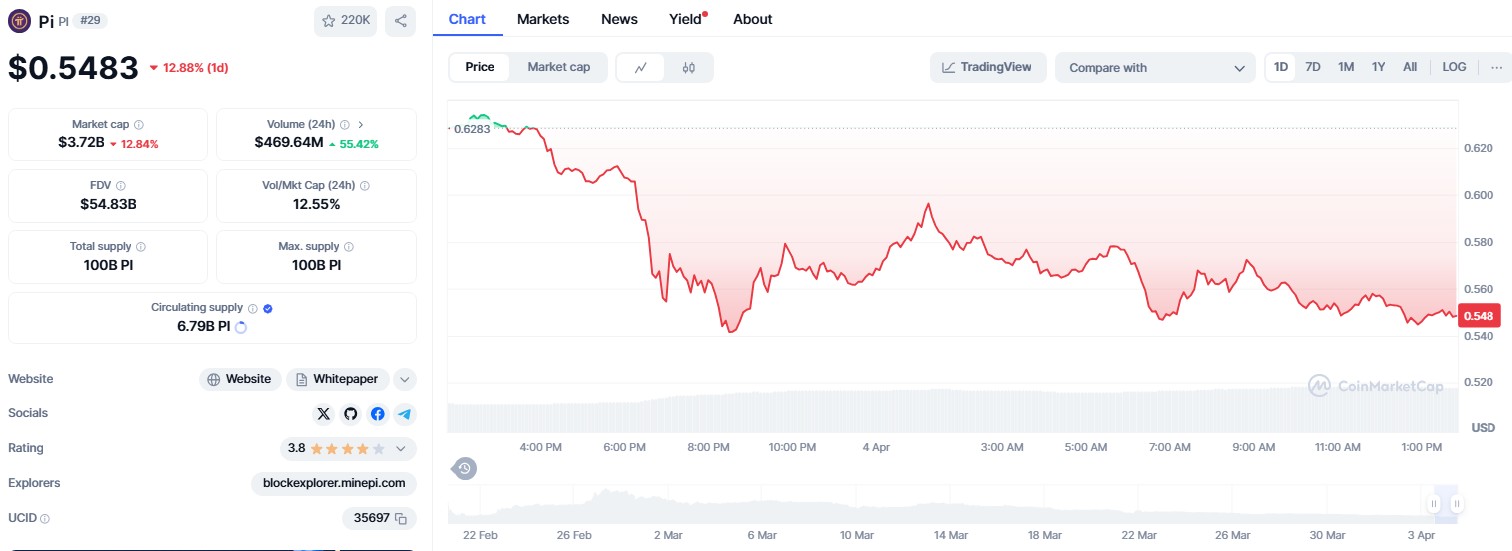- 4.9 billion tokens already in circulation.
- PiFest 2025 saw 1.8 million users across 58,000 merchants.
- Technicals signal further downside; with RSI below 20.
Pi Network’s token, PI, is on a sharp downward trajectory, losing over three-quarters of its value since its February peak.
Despite efforts to boost adoption—including the high-profile PiFest 2025 event—technical indicators and ongoing token unlocks are piling pressure on the cryptocurrency.
As the broader market surges, with Bitcoin trading above $84,000 and Ethereum staying above $1,820, PI’s steep drop sets it apart for all the wrong reasons.
With over 126.6 million tokens being unlocked this month alone, the issue of oversupply continues to weigh heavily on sentiment and pricing.
PiFest drives use, but price drops
Pi Network’s recent push to encourage real-world adoption culminated in PiFest 2025.
The event drew participation from over 125,000 sellers and 58,000 merchants, who collectively enabled more than 1.8 million Pioneers to use PI for everyday transactions.
These ranged from purchases at cafes and boutiques to payments at auto shops and for freelance services.
Despite the extensive scale and real-world utility shown during the event, PI failed to register a positive price reaction.
The token has instead continued its freefall, now trading at $0.5483.
This marks over a 25% decline over the past week alone.
From its all-time high of $2.98 earlier this year, PI has now shed 77 percent of its value, raising serious questions about the effectiveness of Pi Network’s adoption strategy.

Source: CoinMarketCap
126 million tokens unlocked in March
The price drop aligns with Pi Network’s ongoing monthly token unlocks, which are releasing new tokens into the market at a much faster pace than demand can absorb.
Over 4.9 billion PI tokens are already in circulation, and an additional 126.6 million will be unlocked this month.
On average, the network has been releasing 133 million tokens each month, with a further 1.54 billion tokens expected to be unlocked over the next year.
This rising supply, without a corresponding increase in buying pressure or liquidity, is cited as the primary reason behind the token’s persistent downtrend.
Technical indicators support this view. PI is currently trading below its 20-period Exponential Moving Average (EMA), a bearish indicator, and the Relative Strength Index (RSI) has dropped below 20—well into oversold territory.
Analysts note that while the RSI may indicate overselling, there are no strong signs yet of a reversal.
Triangle pattern signals further fall
From a technical perspective, PI’s price movement is following a descending triangle formation—a pattern often linked with continued bearish momentum.
Unless there’s a clear breakout from this pattern, analysts believe PI could soon slide below $0.50 if current selling pressure continues.
A reversal rally, if one occurs, could potentially take the token back toward $1.53, but such a move would require a significant shift in demand and sentiment.
The broader crypto market’s bullish conditions only highlight PI’s poor performance.
While other assets benefit from institutional interest and high liquidity, PI continues to struggle with exchange listings and widespread scepticism.
Project’s history and reputation pose challenges
Pi Network was launched in 2019 with a mobile-first, referral-based mining model.
It remained largely untradable until the mainnet launch, after which it gained listings on exchanges such as Bitget, OKX, and MEXC.
However, concerns about its long-term viability remain.
The project still faces criticism for lacking liquidity, unclear use cases beyond events like PiFest, and resistance from major platforms.
One major exchange, ByBit, has openly refused to list the token.
This stance has further limited the token’s exposure and liquidity in a competitive market where visibility and tradability are essential for success.
Despite recent promotional efforts, Pi Network’s future remains uncertain.
Market watchers believe that unless the token unlock schedule is revised or real user demand catches up to the supply, the downtrend is unlikely to reverse.
For now, the growing number of tokens in circulation and lack of exchange support continue to outweigh the network’s community-driven initiatives.













